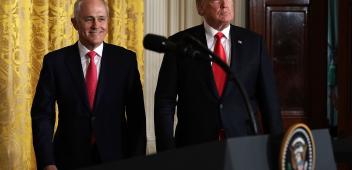What’s gone wrong with our interest rate policy?
The RBA has been forced into lockstep with a misguided US Federal Reserve held hostage by volatile financial markets. Originally published in the Australian Financial Review.

The current debate on Australian monetary policy is misdirected. Interest rates are abnormally low because the US Federal Reserve has pushed them down through excess liquidity and sustained quantitative easing.
All other developed countries (including Australia) have been forced to match these low rates in order to avoid a damaging loss of international competitiveness through an overvalued exchange rate. With policy already so accommodative, further easing would be as ineffective as doubling the prescribed dose of medicine.
Where did this go wrong? The current episode began in America with the 2008 global financial crisis. Interest rates were, correctly, lowered substantially to offset the crisis. QE began as a measure to rescue the housing-finance market but was also aimed at lowering the long-term interest rate – a key price in US finance.
Despite the Fed’s best efforts, the recovery was lacklustre, reflecting the ongoing balance-sheet damage caused by the GFC. The weakness was exacerbated by fiscal policy, in strong contractionary mode from 2011 to 2015 in response to paranoia about government debt. This ill-advised austerity probably took 5 per cent off growth during this five-year period. The Fed valiantly tried to offset these headwinds, at the cost of sustained abnormally low interest rates.
Rather than get into an argument criticising fiscal policy, then-Fed chair Ben Bernanke explained low interest rates in terms of a “global savings glut”. This argument might have carried some weight when Bernanke first made it in 2002. China’s external surplus was huge, reflecting China’s high savings. The surplus flooded into US bonds, driving down yields. But by 2009 China’s saving/investment imbalance was small.
If there was a conundrum in global saving/investment, it was the lack of response of investment to the dramatic fall in funding costs. With borrowing costs low and business profits high, what had happened to entrepreneurial mojo?
Perhaps this shouldn’t be too surprising. Decades of searching for a clear econometric relationship between interest rates and investment has not produced convincing evidence of a linkage. Other factors are more important, such as strong demand. Easy money is an enabler of growth but too much of a good thing can be bad, like an overdose of prescribed medicine.
Someday, a Fed chair will have to make a brave decision to return interest rates to a normal level.
Of course, monetary policy operates through other channels as well. Lower interest rates depreciate the exchange rate, which might help activity if it increases international competitiveness. But if every country tries to do this, the effect is cancelled out under a cacophony of accusations of “beggar thy neighbour” and “exchange rate manipulation”.
There is also a powerful impact on asset prices, conspicuously apparent since 2008. But the net effect on demand is less clear, as the benefit to geared-up borrowers is offset by lower deposit-income for pensioners. Shifting income distribution towards the high-saving rich doesn’t help, either.
Every time the Fed has tried to tighten policy, financial markets have squealed so loudly that the Fed has retreated. The precedent was established even before the GFC, with the “Greenspan put” ever-ready to save financial markets from the downside of their excesses.
The 2013 “taper tantrum” was just another demonstration of the power of financial markets to keep interest rates low by threatening meltdown. The Fed’s attempt to normalise interest rates in 2018 was brought to a swift end by a sharp fall in equity prices. The COVID-19 crisis reminded markets that they had ignored risks, but the Fed stood ready to bail them out once again.
All this leaves the RBA without an effective instrument to influence inflation. The labour market is not tight enough to put pressure on wages, leaving the bank to fall short on its inflation target. The world has changed since inflation targeting successfully contained inflation, 30 years ago. Inflation has been held down ever since China became “manufacturer to the world” early this century and added its huge labour force to global supply.
Inflation of around 2 per cent is still a sensible long-term target, but monetary policy cannot dial this up under current circumstances.
Academic advice is based on models that have no relevance to today’s financial sector. Whatever is restraining economic expansion, it is not the level of interest rates, currently negative in inflation-adjusted terms.
This leaves zombie enterprises operating and irrational exuberance in fringe asset prices while encouraging financial churning and foolish risk-taking. Higher house prices create a political nightmare when interest rates eventually rise. Equity prices, justifiable while interest rates are low, will retrace when interest rates return to normal.
Sooner or later the US must accept that the “savings glut” explanation for low interest rates makes little sense. The evidence is clear: US interest rates are low because the Fed acted to put them low. The Fed is held back from raising rates, not by excess saving, but by the powerful blackmail of the financial sector.
In 1979 then-Fed chair Paul Volcker pushed interest rates to 20 per cent to fix the distortion of high inflation, at a considerable short-term cost to the economy. Someday, a successor Fed chair will have to make a similarly brave decision to return interest rates to a normal level – say 2-3 per cent in inflation-adjusted terms. Until then, the rest of the world, including Australia, has to walk in lock-step with the Fed’s misguided monetary policy.
Stephen Grenville is a former deputy governor of the Reserve Bank of Australia and a non-resident fellow of the Lowy Institute.



